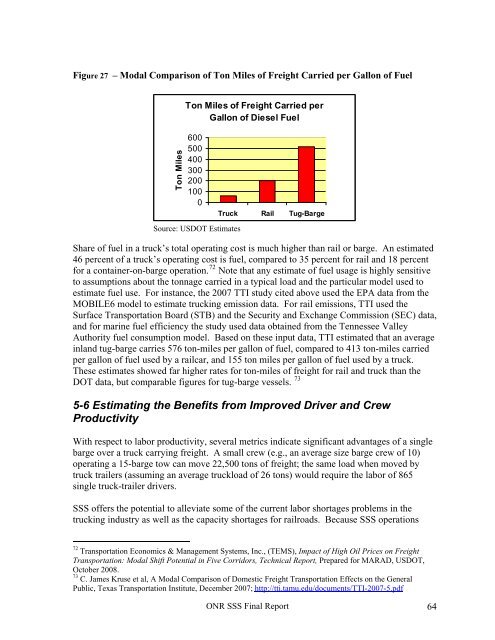Office of Naval Research - National Transportation Library
Office of Naval Research - National Transportation Library
Office of Naval Research - National Transportation Library
Create successful ePaper yourself
Turn your PDF publications into a flip-book with our unique Google optimized e-Paper software.
Figure 27 – Modal Comparison <strong>of</strong> Ton Miles <strong>of</strong> Freight Carried per Gallon <strong>of</strong> FuelTon MilesTon Miles <strong>of</strong> Freight Carried perGallon <strong>of</strong> Diesel Fuel6005004003002001000Source: USDOT EstimatesTruck Rail Tug-BargeShare <strong>of</strong> fuel in a truck’s total operating cost is much higher than rail or barge. An estimated46 percent <strong>of</strong> a truck’s operating cost is fuel, compared to 35 percent for rail and 18 percentfor a container-on-barge operation. 72 Note that any estimate <strong>of</strong> fuel usage is highly sensitiveto assumptions about the tonnage carried in a typical load and the particular model used toestimate fuel use. For instance, the 2007 TTI study cited above used the EPA data from theMOBILE6 model to estimate trucking emission data. For rail emissions, TTI used theSurface <strong>Transportation</strong> Board (STB) and the Security and Exchange Commission (SEC) data,and for marine fuel efficiency the study used data obtained from the Tennessee ValleyAuthority fuel consumption model. Based on these input data, TTI estimated that an averageinland tug-barge carries 576 ton-miles per gallon <strong>of</strong> fuel, compared to 413 ton-miles carriedper gallon <strong>of</strong> fuel used by a railcar, and 155 ton miles per gallon <strong>of</strong> fuel used by a truck.These estimates showed far higher rates for ton-miles <strong>of</strong> freight for rail and truck than theDOT data, but comparable figures for tug-barge vessels. 735-6 Estimating the Benefits from Improved Driver and CrewProductivityWith respect to labor productivity, several metrics indicate significant advantages <strong>of</strong> a singlebarge over a truck carrying freight. A small crew (e.g., an average size barge crew <strong>of</strong> 10)operating a 15-barge tow can move 22,500 tons <strong>of</strong> freight; the same load when moved bytruck trailers (assuming an average truckload <strong>of</strong> 26 tons) would require the labor <strong>of</strong> 865single truck-trailer drivers.SSS <strong>of</strong>fers the potential to alleviate some <strong>of</strong> the current labor shortages problems in thetrucking industry as well as the capacity shortages for railroads. Because SSS operations72 <strong>Transportation</strong> Economics & Management Systems, Inc., (TEMS), Impact <strong>of</strong> High Oil Prices on Freight<strong>Transportation</strong>: Modal Shift Potential in Five Corridors, Technical Report, Prepared for MARAD, USDOT,October 2008.73 C. James Kruse et al, A Modal Comparison <strong>of</strong> Domestic Freight <strong>Transportation</strong> Effects on the GeneralPublic, Texas <strong>Transportation</strong> Institute, December 2007; http://tti.tamu.edu/documents/TTI-2007-5.pdfONR SSS Final Report 64
















